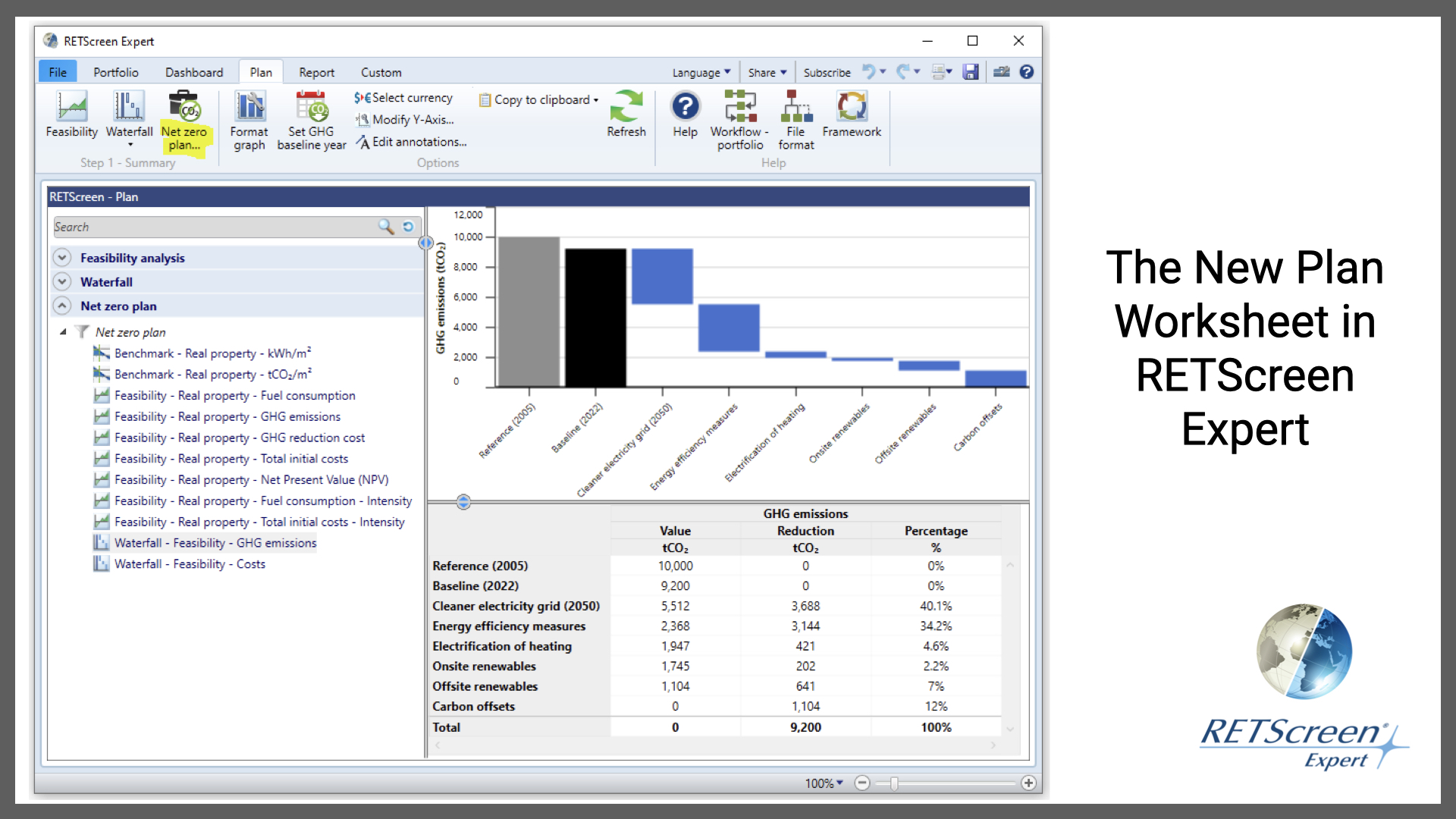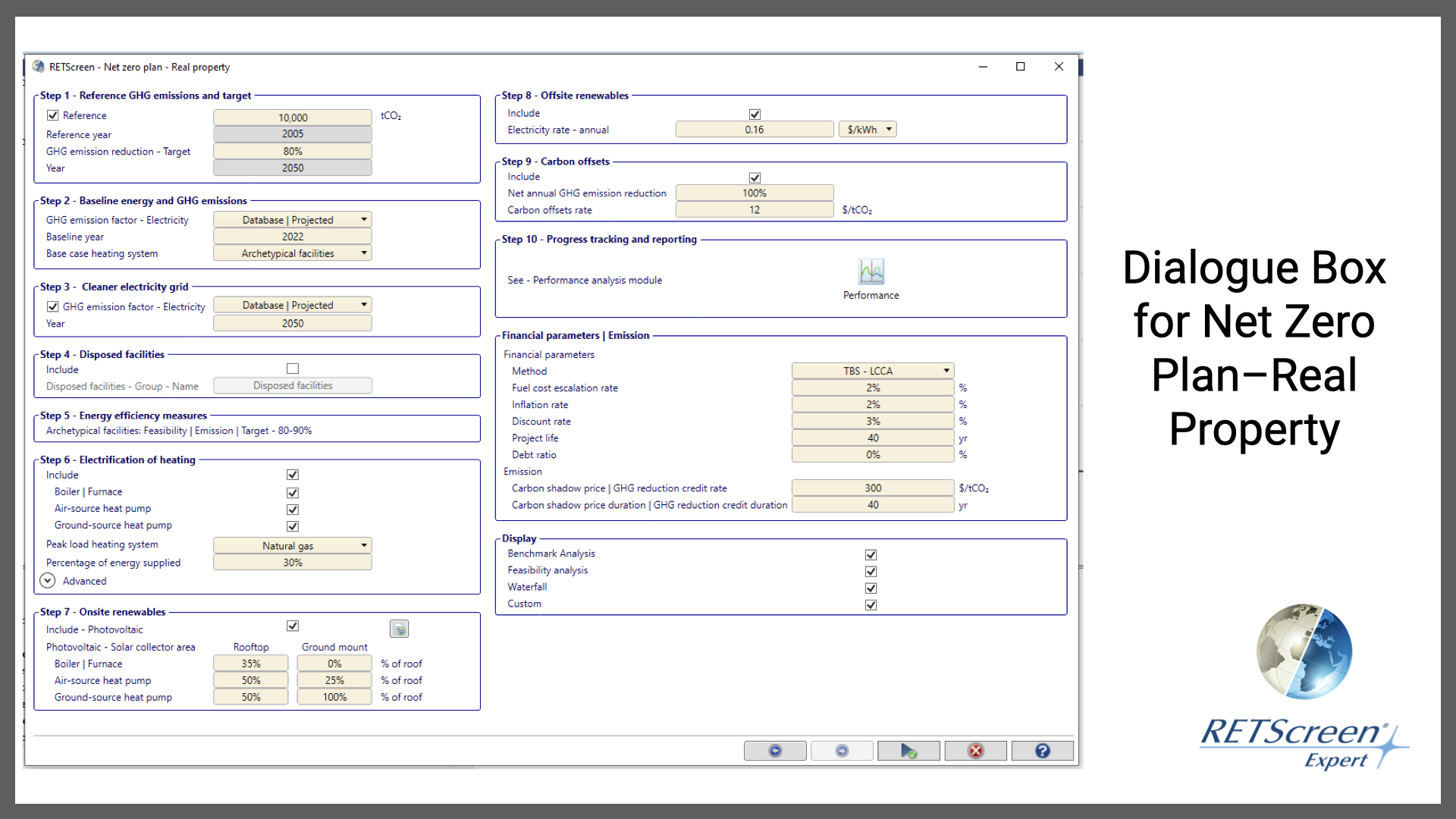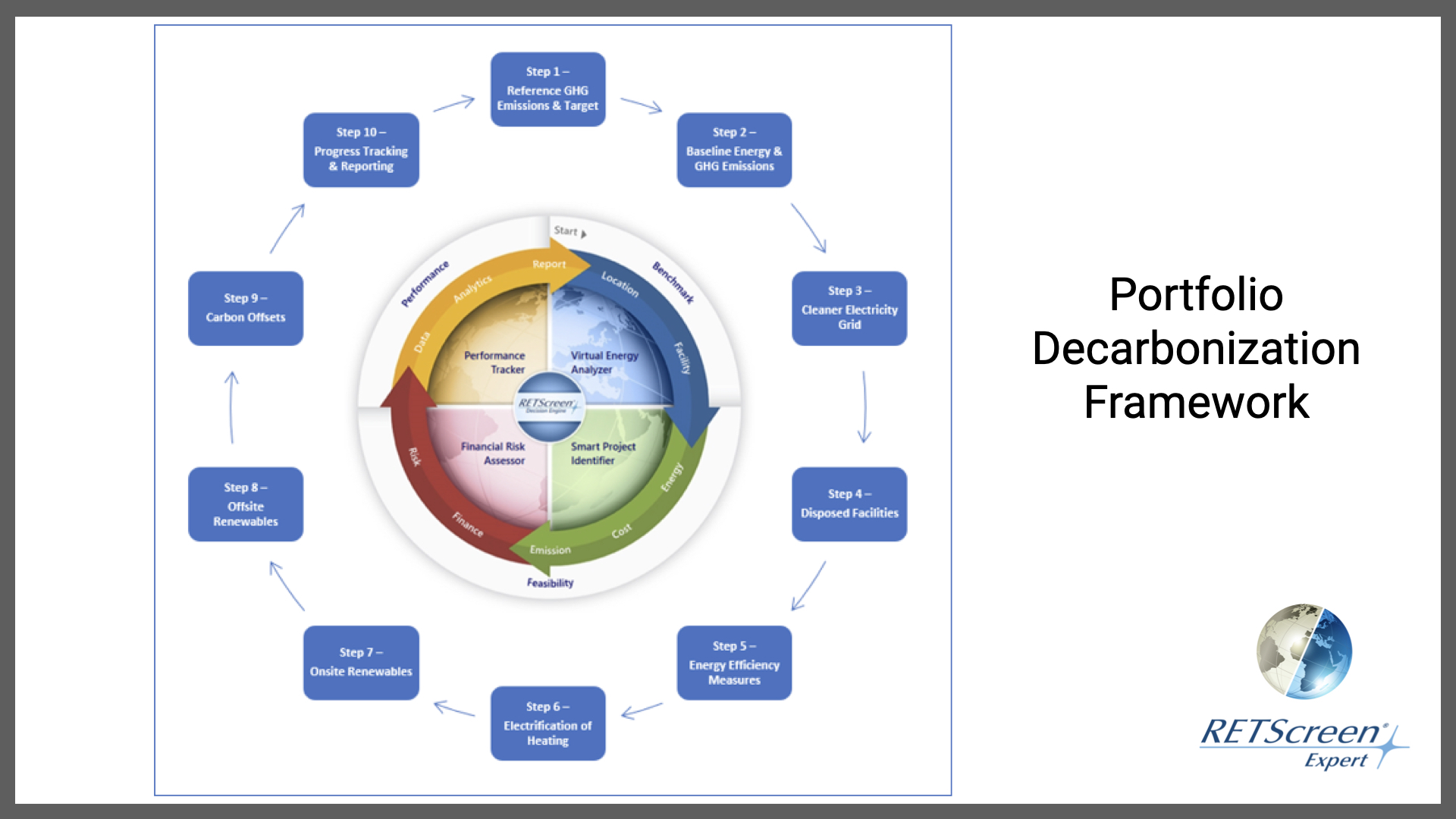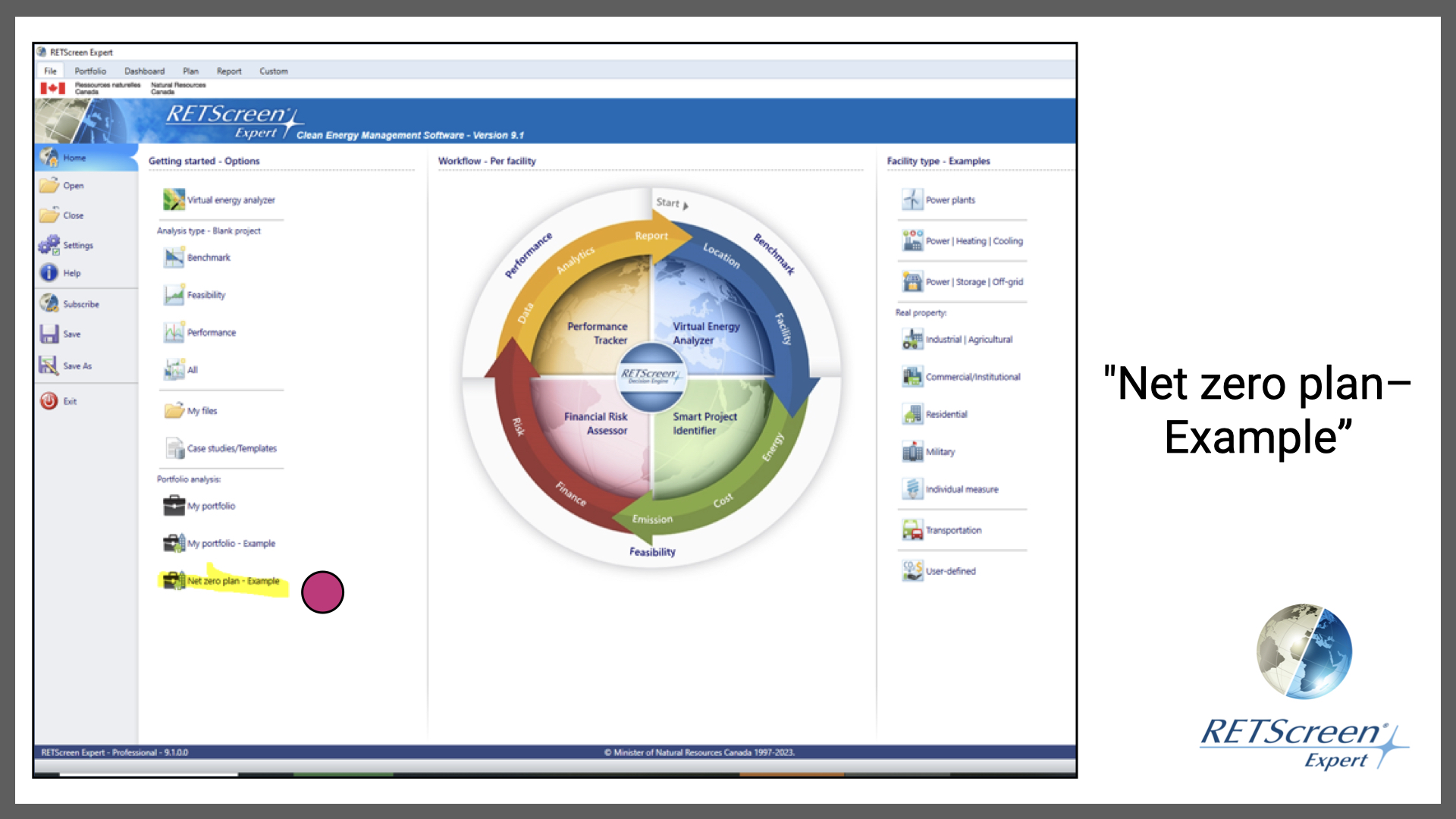
In-Depth
New, automated “Net Zero Planning Tool” in latest RETScreen release
November 30, 2023
By Gregory J. Leng

November 30, 2023 – Here is a brief overview of the new automated Net Zero Planning Tool now available with the latest release of the RETScreen Software (Version 9.1).
With the addition of this powerful new tool, the RETScreen Clean Energy Management Software further enables portfolio-wide decarbonization planning, implementation, monitoring and reporting—all within one single, multilingual platform.
Net Zero Plan–Real Property
The user clicks on the “Net-zero plan…” icon on the ribbon to open the “Net Zero Plan–Real Property” dialogue box to create a portfolio of the real property archetypes available in the Virtual Energy Analyzer. The archetypes accessible within this function are those with both “Feasibility Energy Target 30-40%” and “Feasibility Emission Target 80-90%” versions developed in the Virtual Energy Analyzer.

The Net Zero Plan allows the user to set a GHG emissions reduction target, and guides them through a 10-step Portfolio Decarbonization Framework (described below) for each facility. This concludes in the automatic creation of a portfolio-wide feasibility study, which empowers the user to achieve a net-zero emissions target.

By clicking the “Calculate” button, the software automatically produces a portfolio consisting of chosen archetypes within the Portfolio worksheet, while also generating Benchmark, Feasibility, and Waterfall graphs in the Plan worksheet. Furthermore, a summary of the primary results is generated in the Custom worksheet.
Portfolio Decarbonization Framework
The Portfolio Decarbonization Framework is a 10-step process to prepare a portfolio-wide analysis to assess the feasibility and costs associated with a carbon-neutral real property portfolio, and to help prepare a net-zero plan. An overview of this framework is presented in the figure and described in more details below.

STEP 1: Reference GHG emissions and target. Determine the portfolio’s GHG emissions for a reference year, then set reduction targets relative to that reference year (at one or more years into the future).
(For example, the Government of Canada established fiscal year 2005-2006 as the reference year for GHG emissions reporting by various government departments and agencies.)
STEP 2: Baseline energy and GHG emissions. Establish an appropriate baseline year for energy and GHG model simulations, then calculate, calibrate and adjust (where necessary) the base case energy consumption and associated GHG emissions for the baseline year for the entire portfolio.
Properly establishing the baseline year enables a more accurate evaluation of facility-level energy use. This includes various components of the facility, including specific energy systems and equipment already in place (i.e. the base case), as well as setting the proper foundation to assess the potential for energy and GHG reduction measures and technologies followed in this framework (i.e. the proposed case).
A well-established baseline also facilitates accurate tracking and reporting of the plan’s progress over time, relative to the baseline year.
STEP 3: Cleaner electricity grid. Calculate the portfolio’s projected emissions reduction’s impact toward a cleaner electricity grid. Increasingly, cleaner electricity grids are a key part of public and private sector efforts to help reduce GHG emissions over time. In December 2018, for example, the Government of Canada announced regulations to phase-out traditional coal-fired electricity by 2030, as well as GHG regulations for natural gas-fired electricity.
The disaggregation of the emissions’ impact toward a cleaner electricity grid is an important element of this decarbonization framework. This will help ensure that the plan more accurately reflects the projected overall GHG emissions for each framework element.
STEP 4: Disposed facilities. Determine the projected energy and emissions reductions impact toward disposed facilities across the portfolio. This includes any planned real property consolidation, demolition and/or divestment activities.
STEP 5: Energy efficiency measures. Calculate the projected energy and emissions reduction’s impact toward implementing various energy efficiency measures and technologies at facilities throughout the portfolio.
RETScreen’s Virtual Energy Analyzer incorporates automated decision intelligence to help the user significantly reduce GHG emissions (i.e. deep retrofits) via applying various energy efficiency measures and technologies, by electrifying heating systems, when reducing peak electricity demand, and by automatically sizing both onsite and offsite renewable energy options to be considered.
STEP 6: Electrification of heating. Calculate the projected energy and emissions reduction’s impact toward converting the portfolio’s various fossil fuel heating systems to electricity (e.g. electric boilers or furnaces, air-source heat pumps, ground-source heat pumps, etc.).
In conjunction with cleaner electricity grids, the electrification of space, domestic hot water and process heating systems are an important strategy to help organizations achieve deep GHG emissions reductions.
STEP 7: Onsite renewables. Identify opportunities to implement onsite renewable electricity generation systems and calculate the projected energy and emissions reductions impact toward the installation of onsite renewables at facilities throughout the portfolio.
The cost and efficiency of renewable energy technologies have significantly improved over the past decade. The use of onsite renewable electricity generation systems presents a real opportunity to help reduce emissions in a cost-effective manner. The financial viability and GHG impact of these options are mainly dependent on the local renewable resource available (e.g. the amount of solar radiation available, the speed of the wind at the project site, etc.), installation costs, price of the displaced electricity from the utility, as well as the emissions characteristics of the local electricity grid and the impact of the carbon shadow price.
STEP 8: Offsite renewables. Evaluate the procurement of offsite renewable electricity generation and calculate the projected energy and emissions impact when purchasing offsite renewable electricity for targeted facilities across the portfolio.
Various forms of offsite renewable electricity are increasingly available from public and private power producers to help external organizations indirectly reduce emissions via procurement of cleaner forms of electricity.
Typical renewable resources available include wind, solar, hydro, biomass, landfill gas and other forms of biogas. The green power generated using these fuels is typically sold at a premium price (higher than regular electricity rates paid by facilities) but, as levelized energy costs for large renewable power plants continue to decline, the offsite renewable rates charged are now much closer to retail electricity rates charged by electric utilities.
STEP 9: Carbon offsets. Calculate any remaining emissions reductions required to achieve portfolio-wide net-zero GHG emissions via the potential procurement of external carbon offsets (including carbon removals).
For example, within the Government of Canada’s Greening Government Strategy, net-zero means reducing GHG emissions from operations to as close to zero as possible, then balancing out any remaining emissions with an equivalent amount of carbon removal.
Carbon offset markets are growing rapidly, and there are numerous types of possible offsets for organizations to purchase to help meet reduction targets (e.g. reforestation). However, there is a physical limit globally as to the total amount of GHG reductions that can be achieved via carbon offsets. This is why carbon offsets are considered last as a GHG mitigation step under this framework, intended to help reduce any remaining “harder-to-reduce” emissions.
STEP 10: Progress tracking and reporting. Monitoring and reporting progress is an important final step under this framework and is critical to the long-term success of the plan.
Tracking each facility’s actual energy consumption and associated GHG emissions versus the plan will enable the organization to assess the progress being made and allow energy, facility, and portfolio management teams to identify where deep emissions reductions actions are working (or not working) as planned, and adjust accordingly.
Getting started
The best way to start with this new automated “Net Zero Planning Tool” is to try out the free example by clicking on the “Net zero plan–Example” icon on the bottom left side of the File-Home page of RETScreen Version 9.1. Download RETScreen Expert (9.1) now.
Gregory J. Leng is the creator and director of the RETScreen Clean Energy Management Software platform at Natural Resources Canada’s (NRCan) CanmetENERGY research centre in Varennes, Que. The platform enables low-carbon planning, implementation, monitoring and reporting. He is also a Fellow at the Payne Institute, Colorado School of Mines, in Golden, Colo.
CHECK OUT these RETScreen World Conference 2023 recordings to learn more.
This project is made possible through the financial support of the following organizations:
• Treasury Board of Canada Secretariat–Greening Government Fund
• Department of National–Directorate of Portfolio Innovation, Infrastructure and Environment Group
• Ontario’s Independent Electricity System Operator
The project is spearheaded by the RETScreen Division of CanmetENERGY–Varennes (Natural Resources Canada) with in-kind support from Oxford Properties, 3M Canada, District School Board of Niagara, Mohawk College, Town of Caledon, and CityHousing Hamilton.
Print this page
